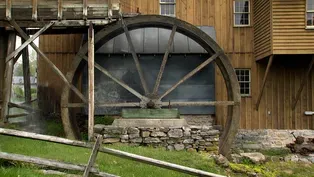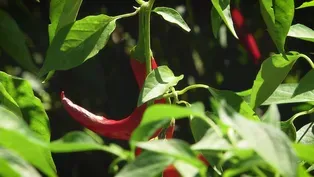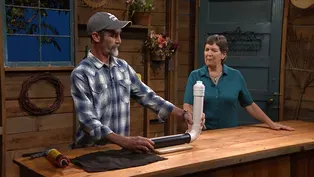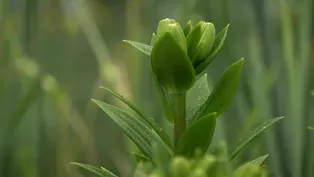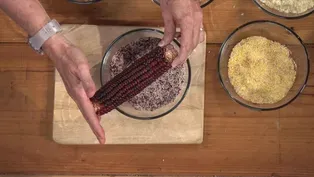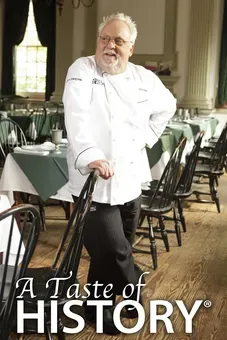Virginia Home Grown
Koi Ponds
Clip: Season 23 Episode 3 | 8m 8sVideo has Closed Captions
A unique water feature for the front door
Peggy Singlemann learns about ornamental water features for the garden when she visits retired landscape designer Bill Pinkham in Isle of Wight to see his 30,000 gallon koi pond and learn about its design and maintenance. Featured on VHG episode 2303; May 2023.
Problems with Closed Captions? Closed Captioning Feedback
Problems with Closed Captions? Closed Captioning Feedback
Virginia Home Grown is a local public television program presented by VPM
Virginia Home Grown
Koi Ponds
Clip: Season 23 Episode 3 | 8m 8sVideo has Closed Captions
Peggy Singlemann learns about ornamental water features for the garden when she visits retired landscape designer Bill Pinkham in Isle of Wight to see his 30,000 gallon koi pond and learn about its design and maintenance. Featured on VHG episode 2303; May 2023.
Problems with Closed Captions? Closed Captioning Feedback
How to Watch Virginia Home Grown
Virginia Home Grown is available to stream on pbs.org and the free PBS App, available on iPhone, Apple TV, Android TV, Android smartphones, Amazon Fire TV, Amazon Fire Tablet, Roku, Samsung Smart TV, and Vizio.
Providing Support for PBS.org
Learn Moreabout PBS online sponsorship>>Bill, you've got just an amazing collector's garden here.
What are some of the features that you have here in your garden?
>>Well, I not only collect plants, I also collect rocks, and this is an up and coming garden feature that's being practiced all over the country.
It's called a crevice garden, but I also use rocks as walkways and retaining walls, and then also as sculptural elements like these basaltic column crystals.
>>Beautiful.
>>That is framed by this nice arch of native bald cypress.
>>Oh, the softness of that just makes it, but, you know, texture-wise, you've put together some wonderful combinations here and colors.
So, when you get a new plant, how do you figure out where to put it?
>>Well, thank you.
It's a challenge.
I walk it a lot.
I walk the garden a lot, finding these spots.
Sometimes I flag them, and then I'm not on yellow plants, and they stand out, particularly evergreens.
Summer and winter, they liven up the garden.
>>Right.
Right.
>>So I try to triangulate those.
>>Yes.
You know, there's so many features to a garden.
You know, texture, color, everything, but also views and water, and you've got it in spades here, my friend, with this amazing view of the James.
That's just gorgeous.
>>The site, Linda found this place and it is amazing.
That's the James River with the Norfolk Naval Base on the other side.
>>It just adds so much.
It opens the garden.
Any other water features?
>>Well, our main water feature's at the front door.
Want me to show you that?
>>Okay.
I'd love that.
(water burbling) Bill, these fish are absolutely beautiful.
How often do you feed them?
>>I feed them twice a day, once in the morning and once in the evening.
>>Mhm, and the water circulation helps a lot with the fish, giving them oxygen?
>>Yes, definitely.
It also is a deterrent for the birds.
So, yes.
>>While we're talking, is it possible to turn off the water?
>>Oh, yeah, sure.
All right.
We're in good shape now.
>>I absolutely love this fountain.
This just is beautiful, and, to be honest, this whole area, you know, I was in Japan a number of years ago, and I feel like I'm back in Japan.
>>Yeah.
>>So, was that your inspiration?
>>Definitely.
We were there in 1976 on a Virginia Tech alumni tour.
It was our first time and the first week was in Tokyo.
The second week was in Kyoto and we did nothing but go to gardens.
>>Oh, sounds like my trip.
>>And we saw this technique.
One had millstones, little millstones, another one had natural stones, and, of course, I love everything Japanese, so I had in the back of my mind that, someday, I was gonna design something.
>>So how deep is the pond?
>>It's two feet deep.
Legally, in the state of Virginia, if it's over two feet of depth, you have to have a fence.
They like a deeper spot in the pond, as much as like five feet.
This is all two feet.
>>How many gallons is it?
>>It's 30,000 gallons.
They say that you're allowed to have one larger fish per 1,000 gallons.
So, the 30,000 can have 30 fish, and that's what I have.
>>And you have beautiful fish.
Absolutely gorgeous.
>>Yeah, some domestic.
Some imported from Japan.
>>Some from Japan.
What a wonderful combination.
Well, tell me about the care of the pond, though, because so many people would love to have a water feature in their landscape, and they really don't know where to get started or even what the care is for it.
So, tell me.
How do you care for this beautiful space?
>>The best thing is to find a source, a local source.
We have a guru over in Newport News, and he has answered all the questions.
That's his life's work.
So, if I have a problem, and they're the ones, they sent somebody over here, actually.
They got me on the right track.
Salinity is probably the number one thing, and I have this meter that you press.
When it zeroes, you stick it in, and it's reading 0.12.
It went up to 0.13.
That's exactly where you want it to be, and the reason for that is, through research, they found that the 0.12 will not kill plants, but it keeps the slime coat on the fish, which is what keeps them healthy.
>>Yes.
That's very important.
Well, you have a water filtration system but I don't see it.
>>Originally, this back here was the filter, and it wasn't enough, not nearly enough, so the water stayed cloudy all the time with algae.
So, at some point, about eight years, seven or eight years ago, I decided we had to build a better filter, and we did that on the side of the house, which is lower than this, which was a little bit of a challenge, because most ponds are on level ground and they put their filter right behind the pond with a waterfall.
>>Right.
Exactly.
>>And that recirculates with one pump.
Because this is higher than the filter, the water has to be pumped down to the filter, through the filter, and then pumped back up back.
So, two pumps.
>>Since it is a biological filtration system, what is the maintenance on it?
>>The filter on the side gets, there's a trap on the pump that gets cleaned every day, and, if I don't, it just builds up on there.
It'd probably burn the pump up.
>>Interesting.
>>The surface of it has to be cleaned off once a month, so you go in and clean that off.
>>Okay.
>>And the reason I didn't do it, because you all were coming, is that it really muddies the water up.
>>Right.
>>And then I have, there's a manifold system underneath the filter with screw caps for clean-outs, and I have this coil of piping I take down there, and I just unscrew it, and, quick, hold it over, and that takes the gunk, algae out, and dumps it into one of the beds.
>>It just sort of helps clear out whatever has been collected.
>>Right.
That's about, every two weeks, I do that.
>>Okay, and then, here, what do you do?
Do you check the salinity every day, or?
>>No, not really.
I check it depending on the rain.
If we get a lot of rain, I check it, and it usually needs more salt.
It's the same salt used in swimming pools.
It doesn't bother the fish.
It's nothing.
It's just salt.
>>What do you do to try to mitigate the temperature of the water?
Do you do anything on a hot summer day?
>>Nothing.
Nah, nothing.
>>Or is all the aeration and bubbling helping to stabilize that?
>>Yeah, it might get pretty hot, but I don't do anything.
>>Oh, interesting.
>>I come out here with ice, maybe.
I'm not gonna do that.
(Peggy and Bill chuckle) Tell me, though.
I'm assuming you must have another door to your house, because if you come home very tired, I don't know if you want to maneuver these stepping stones.
>>We're not gonna be coming in this way if we're drinking, but nobody has ever fallen in this pond.
My sister brought her dog up here from North Carolina and I brought the dog right out here and I turned around about where you're standing, and I turned around, and I said, "See, Jamie?"
About that time, the dog walked right off.
(Bill and Peggy laugh) They don't have any depth perception, and I should have kept walking.
>>You surprised him.
Yeah, surprised him.
So, despite having a dog in the water, for people considering putting a pond at their landscape, what would be your advice?
>>Do the typical one where it's all on one level, and freeform shape.
This is rectilinear, just because, the way it was lined up with the house, I didn't have enough room to do this really informal curvilinear thing out in the yard, so it just made more sense to make this rectilinear, and then these are on cinder blocks, so it's all solid.
>>Nice and low and solid.
Yeah, mhm.
>>Yeah.
>>Would you encourage people to do more of a larger bog?
You know, sort of garden like?
>>If somebody tells you this, you need this for the filter, double it.
>>Double it?
>>Really, because there's never too much filtration.
>>Well, Bill, you know, this, to me, is the ultimate example of a water pond, and it's- >>Oh, thank you.
>>You're welcome.
I love the fact that it's the entry to your home.
>>Yeah.
We do too.
>>And I just love the fact that you've got these beautiful fish, and you've actually, over the years, figured out the best way to manage this, and I thank you so much for sharing this with us.
>>You're welcome.
Video has Closed Captions
Discover uses for water in gardening and agriculture beyond sustaining plants! (26m 46s)
Video has Closed Captions
Discover how the power of water is used to process grain (8m 39s)
Video has Closed Captions
How to build a water feature that meets the goals for your landscape (4m 54s)
Video has Closed Captions
Learn how to harvest and store rainwater safely (3m 12s)
Video has Closed Captions
Learn about the products millers create from corn and wheat (6m 12s)
Providing Support for PBS.org
Learn Moreabout PBS online sponsorshipSupport for PBS provided by:
Virginia Home Grown is a local public television program presented by VPM

